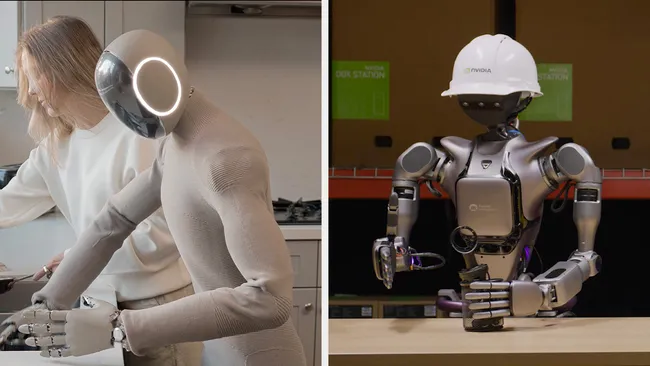NVIDIA has announced a major breakthrough in humanoid robotics with the launch of Isaac GR00T N1, the world’s first open and fully customizable AI foundation model for general-purpose humanoid robots. This model is designed to accelerate the development of autonomous humanoids, making robots more adaptable and capable of performing diverse real-world tasks.
Alongside GR00T N1, NVIDIA introduced a suite of robotics-focused technologies, including the Newton physics engine, developed in collaboration with Google DeepMind and Disney Research, and new AI training tools to supercharge robot learning.

Isaac GR00T N1: The Next Step for Humanoid Robots
The GR00T N1 model is built with a dual-system architecture inspired by human cognition:
- System 1: A fast-thinking reflex-based model, trained on real and synthetic human demonstration data.
- System 2: A deliberate, methodical reasoning model, powered by a vision-language AI system that plans and executes complex tasks.
These capabilities allow GR00T N1-powered robots to generalize across a wide range of tasks, such as:
- Grasping objects
- Using one or both arms to move items
- Performing multi-step sequences
- Adapting to different environments in real-time
NVIDIA is making GR00T N1 available for developers and researchers, enabling them to fine-tune the model using either real-world or synthetic training data for specific robotic applications.
>>>GQ3276RB Replacement Battery for Ulefone Note 10
Leading robotics companies, including 1X Technologies, Agility Robotics, Boston Dynamics, Mentee Robotics, and NEURA Robotics, have already gained early access to GR00T N1.
During his GTC keynote, NVIDIA CEO Jensen Huang showcased a 1X humanoid robot using GR00T N1 to autonomously clean up a home—a demonstration of its advanced learning capabilities.
“The age of generalist robotics is here,” said Huang. “With NVIDIA Isaac GR00T N1 and new robot-learning frameworks, we’re unlocking the next frontier in AI-powered robotics.”
To further advance robotics simulation and AI training, NVIDIA, Google DeepMind, and Disney Research unveiled Newton, an open-source physics engine optimized for robotic learning.
Newton is designed to simulate complex robotic tasks with extreme precision, improving the ability of AI-powered robots to navigate real-world environments. Built on the NVIDIA Warp framework, Newton integrates with:
- Google DeepMind’s MuJoCo-Warp (boosting robotic training speeds by over 70x)
- Disney’s physics engine, already used to develop expressive robotic Disney characters
During the GTC event, Huang showcased Disney’s Star Wars-inspired BDX droids, which use NVIDIA’s technology to enhance their lifelike movements and expressions.
Kyle Laughlin, SVP of Walt Disney Imagineering R&D, emphasized the impact of the collaboration:
“This is just the beginning. With NVIDIA and Google DeepMind, we’re creating robotic characters that can engage with guests in ways the world has never seen before.”
Synthetic Training Data: Scaling AI-Powered Robotics Faster
A major challenge in humanoid robot development is the need for massive datasets for training AI models. NVIDIA is addressing this with the Isaac GR00T Blueprint, an AI-driven synthetic motion generator.
Key highlights:
- Generates training data exponentially faster than real-world human demonstrations
- 780,000 synthetic trajectories (equal to 6,500 hours of human demonstration) created in just 11 hours
- Boosted GR00T N1’s performance by 40% when combined with real-world data
- Additionally, NVIDIA is releasing the GR00T N1 dataset as part of a larger open-source AI robotics dataset on Hugging Face, enabling researchers worldwide to further enhance robotic learning.
>>>G1 Replacement Battery for Machenike L16W
Availability & Future Prospects
- GR00T N1 training data and evaluation tools are now available on Hugging Face & GitHub
- Newton physics engine will be released later this year
- NVIDIA DGX Spark, a personal AI supercomputer, is launching to help developers expand GR00T N1’s capabilities without extensive programming
With these groundbreaking advancements, NVIDIA is shaping the future of humanoid robotics, pushing AI-driven machines beyond industrial applications and into everyday life.